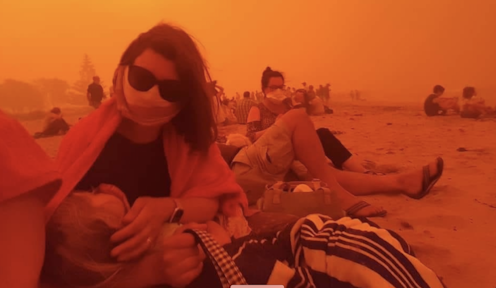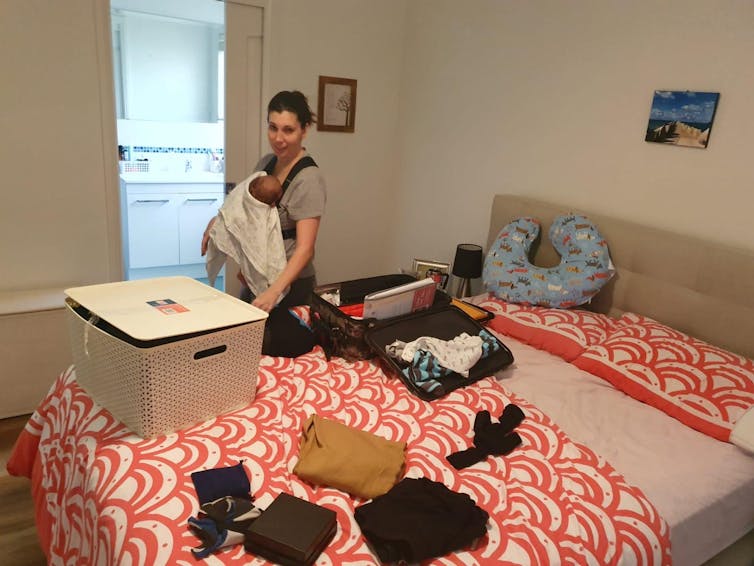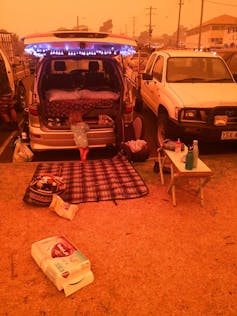
Floods, bushfires, heatwaves, cyclones. Australia is no stranger to emergencies. But during disasters we’re better prepared to support pet owners than families with babies and toddlers.
Until now, the experiences and needs of families with very young children during emergencies have been largely invisible and overlooked.
Our new research, a collaboration between the Australian Breastfeeding Association and Western Sydney University, highlights the challenges faced by the parents of very young children in disasters, and how we need to support them.
We looked at families affected by Australia’s catastrophic Black Summer bushfires of 2019-20. However, there are lessons for how we prepare for, and manage, any type of future emergency.
Read more: 200 experts dissected the Black Summer bushfires in unprecedented detail. Here are 6 lessons to heed
What we did and what we found
We surveyed and interviewed 256 parents of children from newborn to four years old at the time of the Black Summer bushfires, and 63 emergency responders.
We found caring for a very young child profoundly impacted parents’ bushfire experiences. Preparing to evacuate was more complex and physically difficult. Parents were under-prepared. Many did not have an evacuation plan and found it difficult to gather what they needed when they had to leave.

Read more: Evacuating with a baby? Here's what to put in your emergency kit
Evacuation centres weren’t child-friendly
Women commonly evacuated on their own with their partner staying behind to protect property.
These mothers found it difficult to keep their children safe in large evacuation centres due to overcrowding, the presence of strangers and animals, and because there were limited resources for caring for children.

Some emergency responders were aware of the vulnerability of children and their caregivers in large evacuation centres.
They described child protection concerns and physical dangers. They described unsafe practices by unsupported caregivers, such as washing baby bottles in toilet sinks, and unsafe sleep situations. They highlighted a need to proactively support parents.
Parents and emergency responders repeatedly said evacuation centres should have a separate space for families with very young children.
Families who could evacuate to the home of family or friends or to child-friendly venues such as preschools or doctors’ surgeries fared much better. One parent who was evacuated to a preschool told us:
to the children it was like a holiday because they had all the play equipment, they had a huge, big play area out the back.
The kindness of emergency responders, strangers and community members was greatly appreciated. One woman described how a shop employee, after seeing her with her toddler and realising she had evacuated, immediately offered her home saying:
Do you need somewhere to stay? […] I live just walking distance […] here’s my key.
Pregnant women were at risk
Women prioritised their children’s wellbeing over their own and often did not eat or drink properly. This was particularly concerning for pregnant and breastfeeding women.
Two of the five pregnant women we interviewed fainted while queuing for food and assistance. One of these women told us:
I was so worried about my kids. I’d given them water, supplied them with food […] that I would just forget […] to eat myself, to drink […] The ambulance people asked me, ‘Have you had anything to drink today?’ […] I couldn’t even answer the question. I was like, ‘I don’t even remember if I have or not’.
Feeding infants could be hard
Parents often found it difficult to access the resources they needed to care for their children.
Those who were formula feeding found it particularly difficult as infant formula, water, detergent and electricity were often not available. One parent told us:
I had absolutely no way to ensure the bottles were cleaned as we only had a bit of water and paper towel to wipe them out with. The bottles did not have any contact with detergent on over six days.
Those distributing infant formula did not always check whether parents had resources such as clean water or a way of heating water. Donations of infant formula were often out-of-date, not in the location needed, or more than required. One mother told us:
People were trying to help. However it was an overwhelming amount of formula.
Women who were breastfeeding were often grateful they had a secure food supply for their baby. One woman said:
I am so lucky I was still breastfeeding […] I could comfort my baby and make her feel sense of normality, I was also able to feed my child without needing to worry about safe food or bottle preparation and supplies.
Some mothers found it difficult to breastfeed in crowded evacuation centres, became dehydrated or interpreted infant fussiness and frequent feeding as meaning there was a problem with their milk.
They needed support to be able to continue breastfeeding that was not always available and some stopped breastfeeding as a result.
Read more: Babies and toddlers might not know there's a fire but disasters still take their toll
We need to do better in future emergencies
When asked what they would do differently if they were in another emergency, parents said pack an evacuation kit and leave earlier.
But the onus shouldn’t be just on parents. Australian emergency planning and response needs an overhaul to better protect infants and young children, and their caregivers.
Existing emergency policies, planning, and guidance should be evaluated with a “young child lens” and adjusted to ensure families are properly supported. People who are experts on young children should be involved in this work.
Karleen Gribble is Project Lead on the Australian Breastfeeding Association's Community Protection for Infants and Young Children in Bushfire Emergencies Project and is an Australian Breastfeeding Association Scientific Advisor, Educator and Counsellor. Karleen is also on the steering committee of the international interagency collaboration the Infant and Young Child Feeding in Emergencies Core Group. She has been involved in the development of international guidance and training on infant and young child feeding in emergencies for over a decade. She is a member of the Public Health Association of Australia. The research described in this article was supported by an Australian Government Protecting Australian Communities-Local Stream Grant.
Michelle Hamrosi is the Community Engagement Officer on the Australian Breastfeeding Association's Community Protection for Infants and Young Children in Bushfire Emergencies Project. Michelle is also a General Practitioner and an International Board Certified Lactation Consultant, as well as a Clinical Lecturer for the Australian National University’s Rural Medical School. Michelle volunteers as an ABA Breastfeeding Counsellor and Group Leader for the Australian Breastfeeding Association Eurobodalla Group. She is also a member of Doctors for the Environment, Climate and Health Alliance and Australian Parents for Climate Action.
Naomi Hull is an RN, IBCLC, and has an MPH. She works for the Australian Breastfeeding Association (ABA) as Senior Manager, Breastfeeding Information and Research. Naomi volunteers as a Breastfeeding Counsellor on the ABA National Breastfeeding Helpline and as the National Coordinator for the World Breastfeeding Trends Initiative Australia. Naomi is also a member of the Public Health Association of Australia.
This article was originally published on The Conversation. Read the original article.







